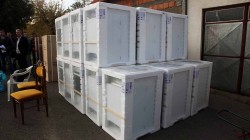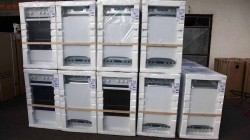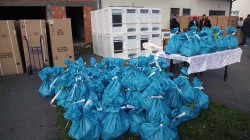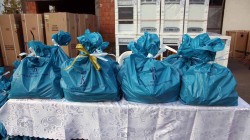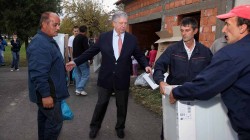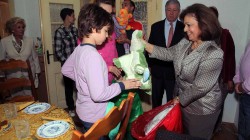
Story by Milica Radovic
“It was horrific, really. It was like we were stuck in the middle of a lake, only the rooftops were peering out of the water. The rain was pouring, the wind was howling, the water was roaring-the type of things you only see in the movies. The uncertainty was the worst, however. There was no way to know how much the water was going to rise, and so you waited. Then the electricity went out. Not an hour went by since the rain started, and the water was already spilling into the house. There was nothing left but to grab the children, the essentials, and carry them upstairs. Everything else- all your belongings- you had to let go. We were thankful at least we were safe. The children were frightened too- they kept asking what we were going to do if the water kept rising. What was there to do? We would have gone to the attic, then to the roof…then we would swim”. Ljiljana Stanojlovic relives the horrific events that took place during last year’s floods in Serbia. Ljiljana, the school teacher in Koceljeva, a small town in Central Serbia, is just one of thousands of people whose lives were forever changed by the devastating May floods.
Serbia has certainly lived through its fair share of devastation, no question there. It was a different kind of devastation- human by its source. This kind of devastation, however-the kind that only the unflinching hand of nature can impart- Serbia hasn’t seen in a while. The scale and the swiftness of impact of the floods were second to none. The damage was estimated at around 1, 55 billion euros. Those, sadly, are not the worst figures. Around 1.6 million people were affected by the floods, 32,000 of which were evacuated from their homes. Fifty-one people lost their lives. Thousands of homes were destroyed, property and animals lost. Some 5000 people had to be placed in make-shift shelters around Belgrade. There were people still sleeping on the floors of these places months after the disastrous rains. And even when the water withdrew, it left chaos in its wake. Landslides destroyed a lot of the structures that somehow made it through the rains. In many towns infrastructure was ruined, production stopped, jobs were lost.
“Fifty square meters of wooden floors was destroyed, the whole kitchen-including all the electric appliances, beds, chairs, tables-all gone.”-Mrs. Stanojlovic shares the scale of the damage on her house. The level of devastation is self-evident, considering Koceljeva was not as badly hit as Obrenovac.
However sudden the floods seemed, the public’s reaction was even quicker. It is truly not an exaggeration to say that the floods mobilized the entire Serbia and the Serbian diaspora as well, especially in Canada and USA.
For weeks people were collecting and carrying around bags of donations -clothes, food, anything they could spare to lose, people were giving away. School children were giving up their lunch money for their less fortunate peers in flooded areas. Collection boxes were placed at every turn. Donations were flying in from all over the world. The promptness of LIFELINE CANADA in collecting and sending funds to Serbia cannot stay unmentioned.
In November of last year, Their Royal Highnesses, Crown Prince Alexander and Princess Katherine set out to the small town of Koceljeva to personally deliver appliances to people who lost everything in the floods, courtesy of fundraising efforts of LIFELINE CANADA. Rows of stoves, refrigerators and other appliances were provided for this cause, as well as some blankets, pillows and toys for the children. Relief was felt in the air as their Royal Highnesses tirelessly handed out donations. Stories of loss and devastation were told, but the gratitude was unspeakable. To someone who had lost everything, a refrigerator and a stove meant more than anyone could imagine. It meant not having to worry about not being able to afford new ones. It was a step toward recovery. Most importantly, it meant a warm meal for their family.
Koceljeva is just one of 10 places LIFELINE CANADA donations reached. There was also Obrenovac, the town most horrendously damaged. There was Kladovo, Krupanj, Grabovica, Tekija, Podvrska, Majur, Prnjavor and Banja Koviljaca. The aid even traveled across the border to the neighboring Republika Srpska, to the towns of Samac and Bijeljina. As many as 220 families were helped in getting back on their feet through donations worth $185,000.00. Moreover, the Canadian government chose the LIFELINE CANADA charity event held on June 6th 2014, in the presence of Their Royal Highnesses, to announce a $840,000.00 donation to be distributed throughout the flooded areas in Serbia.
The story of the May floods of 2014 is a story of great loss and great suffering. It is a story of the unimaginable playing out in mere hours. It is also a story of bravery and selflessness, of empathy travelling across borders and continents, connecting Serbia and Canada. It is a testament of what relying on our shared humanity can do. It stands witness to the fact that “strength in numbers” is not just a worn out saying, but a promise of a brighter future. When disaster strikes, the first thing we can all do is hope it never happens again. If it does, however, nothing is more valuable than knowing that, as long as there are open-hearted people willing to share, we will still have something to fall back on.


